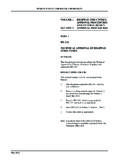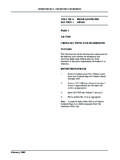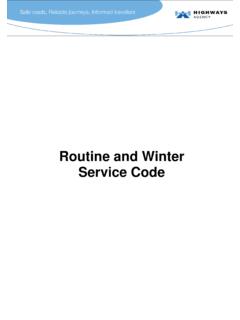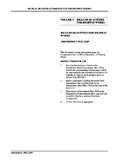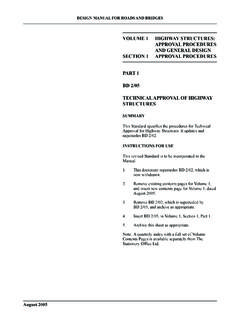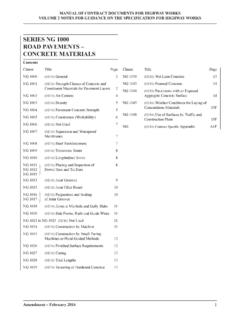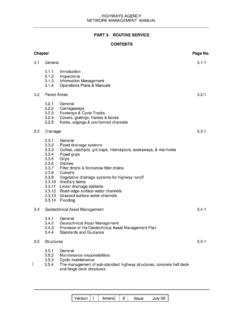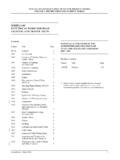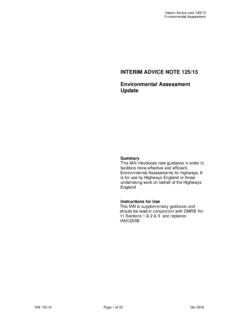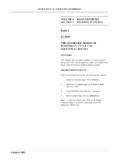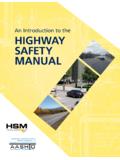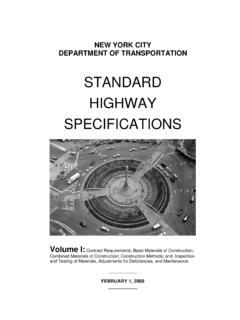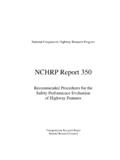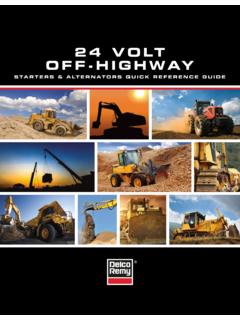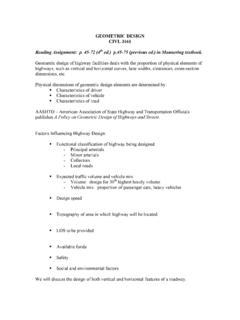Transcription of DMRB VOLUME 1 SECTION 3 PART 5 - BD 60/04 - THE …
1 May 2004 DESIGN MANUAL FOR ROADS AND BRIDGESVOLUME 1 highway STRUCTURES:APPROVAL PROCEDURESAND GENERAL DESIGNSECTION 3 GENERAL DESIGNPART 5BD 60/04 THE DESIGN OF highway BRIDGESFOR VEHICLE COLLISION LOADSSUMMARYThis Standard gives criteria for the design of highwaybridges for vehicle collision loads. It updates andreplaces in part BD 37 FOR USEThis is a new document to be incorporated into Contents pages for VOLUME new Contents pages for VOLUME 1, datedMay BD 60/04 into VOLUME 1, SECTION 3, part archive this sheet as : A quarterly index with a full set of VolumeContents Pages is available separately from TheStationery Office Ltd. BD 60/04 The Design of highway Bridgesfor Vehicle Collision LoadsSummary:This Standard gives criteria for the design of highway bridges for vehiclecollision loads. It updates and replaces in part BD 37 MANUAL FOR ROADS AND BRIDGESTHE HIGHWAYS AGENCYSCOTTISH EXECUTIVEWELSH ASSEMBLY GOVERNMENTLLYWODRAETH CYNULLIAD CYMRUTHE DEPARTMENT FOR REGIONAL DEVELOPMENTNORTHERN IRELANDV olume 1 SECTION 3 part 5 BD 60/04 May 2004 REGISTRATION OF AMENDMENTSA mendPage NoSignature & Date ofAmendPage NoSignature & Date ofNoincorporation ofNoincorporation ofamendmentsamendmentsRegistration of AmendmentsVolume 1 SECTION 3 part 5 BD 60/04 May 2004 REGISTRATION OF AMENDMENTSA mendPage NoSignature & Date ofAmendPage NoSignature & Date ofNoincorporation ofNoincorporation ofamendmentsamendmentsRegistration of AmendmentsVOLUME 1 highway STRUCTURES:APPROVAL PROCEDURESAND GENERAL DESIGNSECTION 3 GENERAL DESIGNPART 5BD 60/04 THE DESIGN OF highway BRIDGESFOR VEHICLE COLLISION A:HGV/Bridge Collision StatisticsAppendix B:HGV/Bridge Collision PhotographsAppendix C.
2 Guidance for Steel and Steel/CompositeBridge DecksDESIGN MANUAL FOR ROADS AND BRIDGESMay 2004 VOLUME 1 SECTION 3 part 5 BD 60/04 May 20041/1 Chapter 1 Introduction1. collisions of heavy goods vehicleswith the supports and superstructures of highwaybridges occur quite frequently on a national gathered from such accidents (see AppendixA) show that collisions take place with bridge decks ofstandard (or greater) headroom clearance and on roadsof most categories. Although, so far, only one trunkroad bridge has been completely dislodged by acollision, several footbridges and sign/signal gantrieshave been partly or totally removed from their supportsand hence the potential is there for a major catastropheunless appropriate action is taken both for existingbridges and in respect of future bridges. Appendix Bshows photographs of some collisions with Department of Transport set up a workingparty to examine ways of protecting existing bridgesfrom large goods vehicle collisions.
3 The working party,which originally concentrated on railway over-bridgestrikes, considered highway bridges. Variouspreventative measures were considered, some of whichwere implemented. The Highways Agency also assessedand strengthened bridge supports that were consideredto be particularly at risk with respect to collision loads;the requirements are contained in BD 48(DMRB ). purpose of this Standard is to promulgate thecollision loading requirements for new highway bridgesand foot/cycle track bridges, as a revision of AppendixA Clauses and of BD 37/01 (DMRB ), whichit supersedes [except for the design of certain foot/cycletrack bridge supports (see )]. For bridges other thanhighway or foot/cycle track bridges, such as railbridges, over a highway , the application of thisStandard shall be agreed with the appropriate revised loading represents, more realistically, thepossible effects of heavy goods vehicle collisions and isconsistent with other national and internationalrequirements.
4 This Standard contains the loading, broadprinciples for its application and some specificguidelines for Gantries and Lighting Standard does not cover the design of sign/signal gantries, lighting columns or lightweight maststructures such as CCTV Standard does not cover the design ofgeotechnical structures, such as corrugated steel buriedstructures or reinforced soil Standard should be used forthwith for allschemes currently being prepared provided that, in theopinion of the Overseeing Organisation, this would notresult in significant additional expense or delayprogress. Design Organisations should confirm itsapplication to particular schemes with the licensing purposes an HGV (Heavy GoodsVehicle) has been recently renamed as an LGV (LargeGoods Vehicle). The term HGV is used throughout 1 SECTION 3 part 5 BD 60/04 May 20042/1 Chapter 2 The Requirements2. THE REQUIREMENTSV ehicle Collision Loads on highway and Foot/CycleTrack Bridge Supports and collision loads on supports andsuperstructures shall be considered for the design ofbridges as secondary live loads, as defined in BD 37(DMRB ), and shall be applied in Load Combination4, also described therein.
5 No other live load shall beconsidered as bridges over carriageways have supportsof which any part is located less than from theedge of a carriageway (see BD 37 (DMRB ) fordefinition) these shall be designed to withstand thevehicle collision loads given in Table 3. Where bridgesupports are located equal to or greater than fromthe edge of carriageway, the Designer is required toanalyse the vulnerability of the supports to vehicularimpact. The Designers should use engineeringjudgement and risk assessment techniques to ascertainthe level of risk and vulnerability. Where theassessments indicate that the potential risk of vehicularimpact is severe, the supports shall be designed to thosecollision loads given in Table 3 or appropriateadditional mitigation measures, eg safety barriers, shallbe provided. The Designer s choice of action in thisrespect and the design collision loads shall be recordedas appropriate eg in AIP in accordance with BD 2(DMRB ).
6 As a general guidance, it is intended thatthe definition of above-mentioned severe potential riskof vehicular impact would only apply to special casessuch as footbridges with single column support, majorlong span bridges etc. However, where foot/cycle trackbridge ramps and stairs are structurally independent ofthe main highway -spanning structure, their supportsmay be designed to the loads specified in Appendix AClause of BD 37/01 (DMRB ), as shall all bridgesupports with a carriageway clearance equal to orgreater than except where considered vulnerableby the Designer and where additional mitigationmeasures are not provided (see Table 1). In the case ofmulti-level carriageways, such as those encountered inmotorway, trunk or principal road interchanges, thecollision loads are to be considered for each level ofcarriageway separately. Vehicle collision on abutmentsneed not normally be considered as they are assumed tohave sufficient mass to withstand the collision loads forglobal purposes.
7 Where bridges have a headroomclearance of less than metres plus sag radiuscompensation and deflection of structure in accordancewith TD 27 (DMRB ), the vehicle collision loads onsuperstructures shall be considered (see Table 2). Theminimum headroom clearance shall be in accordancewith TD 27 (DMRB ). The vehicle collision loads onsuperstructures are not applicable to the superstructureof foot/cycle track bridges, as these are required to haveheadroom exceeding the applicable limit to mitigate theeffects of their lightweight nature. However adequaterestraint on the deck shall be provided to prevent thedeck being removed from the support under the actionof vehicle collision forces given in Table 1 SECTION 3 part 5 BD 60/04 May 20042/2 Chapter 2 The RequirementsCollision loads on supportsClearance from edge of carriageway< bridges:PiersTable 3 Appendix A Clause & Table 15 of BD 37/01 ORTable 3, where applicable and whereadditional mitigation measures arenot providedFoot/cycle track bridges:Main piers including ramps and stairsTable 3 Appendix A Clause & Table 15of BD 37/01 ORTable 3, where applicable and whereadditional mitigation measuresare not providedRamps and stairs that are structurallyAppendix A Clause &Appendix A Clause &independent of the main highway - Table 15 of BD 37/01 Table 15 of BD 37/01spanning structureTable 1.
8 Vehicle collision loads on supports of bridges over highwaysCollision loads on superstructuresHeadroom clearance< ( + sag ( + sagradius compensation + deflection ofradius compensation + deflection ofstructure)structure) highway bridges:Table 4 Not requiredFoot/cycle track bridges:Not applicableNot requiredTable 2: Vehicle collision loads on bridge superstructures over highwaysVolume 1 SECTION 3 part 5 BD 60/04 May 2004 Nominal Loads on nominal loads are given in Table 3 togetherwith their direction and height of application, and shallbe considered as acting horizontally on bridge shall be capable of resisting the main andresidual load components acting simultaneously. Loadsnormal to the carriageway shall be consideredseparately from loads parallel to the normal to theLoad parallel to thePoint of application on bridgecarriageway belowcarriageway belowsupportMain loadkNkNAt the most severe point between m and mcomponent5001000above carriageway levelResidual load250500At the most severe point between 1m and 3m abovecomponent(100)(100)carriageway levelTable 3: Nominal Collision Loads on Supports of Bridges over HighwaysNote: Figures within brackets are applicable for foot/cycle track bridges (see paragraph )Nominal Loads on nominal loads are given in Table 4 togetherwith their direction of application.
9 The load normal tothe carriageway shall be considered separately from theload parallel to the carriageway. The loads shall beconsidered to act as point loads on the bridgesuperstructure in any direction between the horizontaland vertical. The load shall be applied to the bridgesoffit, thus precluding a downward vertical that the plane of the soffit may follow a super-elevated or non-planar (curved) form, the load normalto the carriageway may be applicable in either normal to theLoad parallel to thePoint of application on bridgecarriageway belowcarriageway belowsuperstructurekNkNOn the soffit in any inclination between250500the horizontal and the (upward) verticalTable 4: Nominal Collision Loads on highway Bridge Superstructures over HighwaysGeneral intention behind these requirements is thatthe overall structural integrity of the bridge should bemaintained following an impact but that local damageto a part of the bridge support or deck can be and Superstructures of checks shall be carried out in two stagesas described below:Stage 1.
10 At the moment of impact. A check is to bemade at ULS only, using the nominal impact loads withpartial factors fL appropriate to load combination 4. Noother live load is to be included in this check. Localdamage is to be ignored. It is to be assumed that fulltransfer of the collision forces from the point of impacttakes place. For the bridge, as in design for all otherload cases, the designer shall determine a likely andreasonable load-path to transfer the impact loads to thebearings, supports and foundations (in the case ofsuperstructure strikes) or to foundations, bearings orother supports (in the case of support strikes). Eachstructural element in the load-path is to be considered,starting with the element which sustains the immediateimpact. If it is assumed or found to be inadequate, itmay nevertheless be assumed to have effected thetransfer to the next element(s) in the load-path, but itmust be neglected in carrying out the Stage 2 element in the load-path shall be considered onthe same basis.
